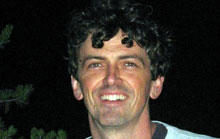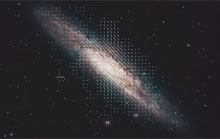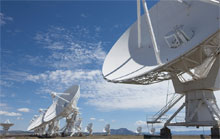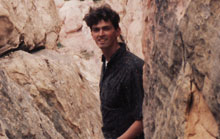
Dr. Chris De Pree (2008)

Vectors computed from VLA and 100-m Effelsberg telescope radio data show the galaxy NGC 253 magnetic field orientation, superposed on ESO Wide Field Imager optical data. Volker Heesen (AIRUB); NRAO/AUI/NSF.

The NRAO Very Large Array near Socorro, New Mexico.

Chris De Pree (1992)
The NRAO Summer Student Program:
Celebrating Five Decades of Training Young Scientists
Dr. Chris De Pree
Deputy Spectrum Manager
National Radio Astronomy Observatory
NRAO Summer Student: 1993, Socorro
NRAO Mentor: Miller Goss
NRAO Project: "Bipolar Outflows in the HII Region K3 50"
NRAO Summer Student: 1992, Socorro
NRAO Mentor: Chris Carilli
NRAO Project: "Discovery of a Synchrotron Emitting Halo around NGC 253"
Education:
Ph.D., Physics, University of North Carolina - Chapel Hill
M.S., Physics, University of North Carolina - Chapel Hill
B.S., Physics, Duke University
Do I really want to be an astronomer? I think that the NRAO summer student program is a fantastic way to answer that question. The program introduces students to the larger astronomical community and exposes them to the real life of a practicing scientist. When I was a professor at Agnes Scott College (1996-2021), I always advised my students that they can take all the courses they want and visit numerous graduate schools, but none of these activities can substitute for a summer research experience at a major observatory like NRAO.
Just after starting graduate school, I spent the summer of 1991 at the Triangle Universities Nuclear Laboratory (TUNL) in Durham, NC, and quickly realized that nuclear physics was not my calling. One of my University of North Carolina professors (radio astronomer Wayne Christiansen) suggested that I would enjoy the NRAO summer student program. His experiences with NRAO had been overwhelmingly positive, and so I submitted my application in early 1992.
I was offered a position in Socorro, NM, working with NRAO scientist Chris Carilli, reducing multi-wavelength radio data of NGC 253, a starburst galaxy that Chris and his colleagues had observed with the Very Large Array (VLA). My scientific objective was to determine radio spectral indices of sources in this intriguing galaxy. Chris also connected this work to his research on galactic "chimneys."
As the summer progressed, I participated in drafting my first professional publication, an important milestone in my development as a scientist: "Discovery of a Synchrotron Emitting Halo around NGC 253", C.L. Carilli, M.A. Holdaway, P.T.P. Ho, C.G. De Pree, 1992, ApJ, 399, L59. The following January, I attended the American Astronomical Society meeting in Arizona, where we presented our results, another valuable opportunity.
During my VLA tour that first summer, I climbed onto one of the 25-meter antennas with a group of students and crawled near its edge (this was before the 7 mm system was installed!). From well above the Plains of San Augustin, the VLA's scale was impressive. Radio antennas dotted the ground into the distance, and I understood that I could be part of something important and exciting, and that a considerable investment had been made to enable all this research, including mine. At that moment, I knew that I wanted to be a radio astronomer.
I returned to the NRAO the next summer to reduce continuum and spectral line VLA observations of a bipolar HII region, K3 50, working with Miller Goss. We analyzed this object's structure and He/H ratio, discovering that K3 50 was rotating and had a high velocity bipolar outflow. Another publication resulted: "A Bipolar Outflow of Ionized Gas in K3 50A", C.G. De Pree, W.M. Goss, P. Palmer, & R. Rubin, 1994, ApJ, 428, 670. I learned hat summer that my interests favored galactic over extragalactic research; Miller soon invited me to the NRAO as a pre-doctoral student.
Chris De Pree has served as National Radio Dynamic Zone Project Director and Deputy Spectrum Manager for NRAO in Charlottesville, VA since July 2021.
